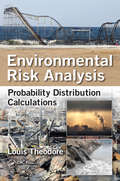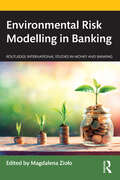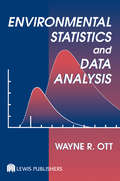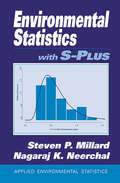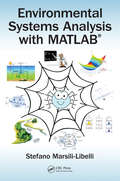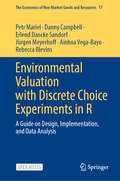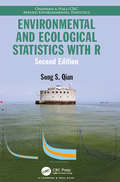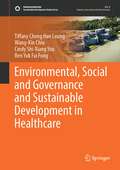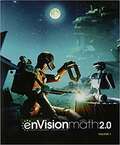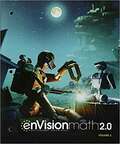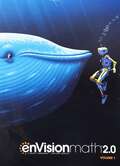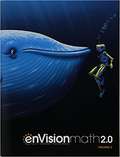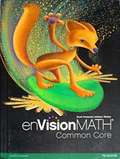- Table View
- List View
Environmental Radiation Effects on Mammals
by Olga A. SmirnovaThe monograph is devoted to theoretical studies of radiation effects on mammals. It investigates the effects of both acute and chronic irradiation on vital body systems (hematopoiesis, small intestine, and humoral immunity), on the development of autoimmune diseases and on the mortality dynamics in homogeneous and nonhomogeneous (in radiosensitivity) mammalian populations. All are set within the framework of biologically motivated mathematical models. The developed methodology of the studies, the models themselves, and the obtained results are of a great theoretical significance and can find wide practical use for those dealing with the problems of environmental protection and radiation safety.
Environmental Risk Analysis: Probability Distribution Calculations
by Louis TheodoreA Training Tool for the Environmental Risk ProfessionalEnvironmental Risk Analysis: Probability Distribution Calculations defines the role that probability distributions play in risk analysis, and gives direction on how to measure and compare the magnitude of risk more efficiently. Designed for the practicing environmental engineer and scientist, t
Environmental Risk Modelling in Banking (Routledge International Studies in Money and Banking)
by Magdalena ZiołoEnvironmental risk directly affects the financial stability of banks since they bear the financial consequences of the loss of liquidity of the entities to which they lend and of the financial penalties imposed resulting from the failure to comply with regulations and for actions taken that are harmful to the natural environment. This book explores the impact of environmental risk on the banking sector and analyzes strategies to mitigate this risk with a special emphasis on the role of modelling. It argues that environmental risk modelling allows banks to estimate the patterns and consequences of environmental risk on their operations, and to take measures within the context of asset and liability management to minimize the likelihood of losses. An important role here is played by the environmental risk modelling methodology as well as the software and mathematical and econometric models used. It examines banks’ responses to macroprudential risk, particularly from the point of view of their adaptation strategies; the mechanisms of its spread; risk management and modelling; and sustainable business models. It introduces the basic concepts, definitions, and regulations concerning this type of risk, within the context of its influence on the banking industry. The book is primarily based on a quantitative and qualitative approach and proposes the delivery of a new methodology of environmental risk management and modelling in the banking sector. As such, it will appeal to researchers, scholars, and students of environmental economics, finance and banking, sociology, law, and political sciences.
Environmental Statistics and Data Analysis
by Wayne R. OttThis easy-to-understand introduction emphasizes the areas of probability theory and statistics that are important in environmental monitoring, data analysis, research, environmental field surveys, and environmental decision making. It communicates basic statistical theory with very little abstract mathematical notation, but without omitting importa
Environmental Statistics with S-PLUS
by Steven P. Millard Nagaraj K. NeerchalA clear, comprehensive treatment of the subject, Environmental Statistics with S-PLUS surveys the vast array of statistical methods used to collect and analyze environmental data. The book explains what these methods are, how to use them, and where to find references to them. In addition, it provides insight into what to think about before you coll
Environmental Systems Analysis with MATLAB®
by Stefano Marsili-LibelliExplore the inner workings of environmental processes using a mathematical approach. Environmental Systems Analysis with MATLAB® combines environmental science concepts and system theory with numerical techniques to provide a better understanding of how our environment works. The book focuses on building mathematical models of environmental systems, and using these models to analyze their behaviors. Designed with the environmental professional in mind, it offers a practical introduction to developing the skills required for managing environmental modeling and data handling. The book follows a logical sequence from the basic steps of model building and data analysis to implementing these concepts into working computer codes, and then on to assessing their results. It describes data processing (rarely considered in environmental analysis); outlines the tools needed to successfully analyze data and develop models, and moves on to real-world problems. The author illustrates in the first four chapters the methodological aspects of environmental systems analysis, and in subsequent chapters applies them to specific environmental concerns. The accompanying software bundle is freely downloadable from the book web site. It follows the chapters sequence and provides a hands-on experience, allowing the reader to reproduce the figures in the text and experiment by varying the problem setting. A basic MATLAB literacy is required to get the most out of the software. Ideal for coursework and self-study, this offering: Deals with the basic concepts of environmental modeling and identification, both from the mechanistic and the data-driven viewpoint Provides a unifying methodological approach to deal with specific aspects of environmental modeling: population dynamics, flow systems, and environmental microbiology Assesses the similarities and the differences of microbial processes in natural and man-made environments Analyzes several aquatic ecosystems’ case studies Presents an application of an extended Streeter & Phelps (S&P) model Describes an ecological method to estimate the bioavailable nutrients in natural waters Considers a lagoon ecosystem from several viewpoints, including modeling and management, and more
Environmental Valuation with Discrete Choice Experiments in R: A Guide on Design, Implementation, and Data Analysis (The Economics of Non-Market Goods and Resources #17)
by Danny Campbell Petr Mariel Jürgen Meyerhoff Erlend Dancke Sandorf Ainhoa Vega-Bayo Rebecca BlevinsThis open access book offers advice and practical guidance for conducting discrete choice experiments (DCEs) in environmental valuation. It covers essential aspects of designing, implementing, and analysing choice experiments. Each chapter includes scripts and guidance, showcasing how to execute every step of a DCE using the free statistical computing and graphics software, R. This feature enhances accessibility and versatility for researchers in the field. While not providing strict guidelines, the book assists readers in steering clear of common mistakes encountered in applied work. With its insights and expertise, it equips researchers and practitioners to effectively navigate the complexities of DCEs.
Environmental and Ecological Statistics with R (Chapman & Hall/CRC Applied Environmental Statistics)
by Song S. QianEmphasizing the inductive nature of statistical thinking, Environmental and Ecological Statistics with R, Second Edition, connects applied statistics to the environmental and ecological fields. Using examples from published works in the ecological and environmental literature, the book explains the approach to solving a statistical problem, covering model specification, parameter estimation, and model evaluation. It includes many examples to illustrate the statistical methods and presents R code for their implementation. The emphasis is on model interpretation and assessment, and using several core examples throughout the book, the author illustrates the iterative nature of statistical inference. The book starts with a description of commonly used statistical assumptions and exploratory data analysis tools for the verification of these assumptions. It then focuses on the process of building suitable statistical models, including linear and nonlinear models, classification and regression trees, generalized linear models, and multilevel models. It also discusses the use of simulation for model checking, and provides tools for a critical assessment of the developed models. The second edition also includes a complete critique of a threshold model. Environmental and Ecological Statistics with R, Second Edition focuses on statistical modeling and data analysis for environmental and ecological problems. By guiding readers through the process of scientific problem solving and statistical model development, it eases the transition from scientific hypothesis to statistical model.
Environmental, Social and Governance and Sustainable Development in Healthcare (Sustainable Development Goals Series)
by Ben Yuk Fong Tiffany Cheng Leung Wang-Kin Chiu Cindy Shi-Xiang YouThis book applies environmental, social and governance (ESG) to issues of sustainable development in healthcare. ESG reporting has been widely used for some time in the business industry to show the economic, social and environmental responsibilities of companies that aim to achieve superior ESG performance for lower risk, more accountability and transparency. Moreover, public-listed companies in healthcare have been growing in significant numbers in recent years. The application or practice of ESG in healthcare has become a growing trend for these large organisations looking to demonstrate their strengths in areas of financing, operations, sustainability and social responsibilities. Such an approach is essential not only for the long-term development of the companies but also for services delivered by healthcare practitioners. Equally, the implications to Sustainable Development Goal (SDG) 3 is relevant to healthcare worldwide with a growing ageing population, which has led to a great burden of care in many countries, particularly in the public sector. The potential development and expansion in private healthcare services, accelerated by technology advancement, has demanded a new paradigm in the healthcare industry, particularly in business, service delivery and policy. The book examines this paradigm through health in all policies, ESG and SDG 3 objectives, research, training and practice. It is relevant to graduate students and scholars working in areas relating to health, business and the SDGs and is also useful to policymakers and practitioners in healthcare.
Envision AGA: Algebra 2 Grade 10/11
by Prentice-Hall Staff"enVision A G A ©2018 is a brand-new high school mathematics program. It includes Algebra 1, Geometry, and Algebra 2. enVision A G A helps students look at math in new ways, with engaging, relevant, and adaptive content. For teachers, the program offers a flexible choice of options and resources. Customize instruction, practice, and assessments. Re-energize students and help them become more self-directed and independent learners"-
Envision Aga Algebra 2 Grade 10/11: Common Core Student Edition
by Prentice-Hall Staff"enVision A G A ©2018 is a brand-new high school mathematics program. It includes Algebra 1, Geometry, and Algebra 2. enVision A G A helps students look at math in new ways, with engaging, relevant, and adaptive content. For teachers, the program offers a flexible choice of options and resources. Customize instruction, practice, and assessments. Re-energize students and help them become more self-directed and independent learners"
Envision Algebra 1: Common Core Grade 8/9
by Prentice-Hall StaffEnVision A G A ©2018 is a brand-new high school mathematics program. It includes Algebra 1, Geometry, and Algebra 2. enVision A G A helps students look at math in new ways, with engaging, relevant, and adaptive content. For teachers, the program offers a flexible choice of options and resources. Customize instruction, practice, and assessments. Re-energize students and help them become more self-directed and independent learners.
Envision Geometry
by Prentice-Hall StaffEnVision A G A ©2018 is a brand-new high school mathematics program. It includes Algebra 1, Geometry, and Algebra 2. enVision A G A helps students look at math in new ways, with engaging, relevant, and adaptive content. For teachers, the program offers a flexible choice of options and resources. Customize instruction, practice, and assessments. Re-energize students and help them become more self-directed and independent learners
Envision Math 2. 0 Hardcover Student Edition Grade 7 Volume 1 Copyright 2017
by Scott ForesmanEnvision Math 2.0 Hardcover Student Edition Grade 7 Volume 1
Envision Math 2.0 Common Core Student Edition: Grade 8, Volume 1 (Envision Math)
by Scott ForesmanEnvision Math 2.0 Common Core Student Edition Grade 8 Volume 1 Copyright 2017
Envision Math 2.0: Grade 6 (Volume 1)
by Scott ForesmanIn like new condition, having never been issued. Paperback enVision Math 2.0 grade 6 Volume 1 Topics 1-4 student edition.
Envision Math 2.0: Grade 7 (Volume 1)
by Scott ForesmanSoft cover enVision Math 2.0 grade 7 Volume 1 Topics 1-4 student edition.
Envision Math 2.0: Grade 7 (Volume 2)
by Scott ForesmanPaperback enVision Math 2.0 grade 7 Volume 2 student book.
Envision Math 2017 Student Edition Grade 5 Volume 1
by Scott ForesmanENVISION MATH 2017 STUDENT EDITION GRADE 5 VOLUME 1 By Scott Foresman
Envision Math 2017 Student Edition Grade 5 Volume 2
by Scott ForesmanenVisionmath 2.0 [Grade 5] Volume 2 Topics 8-16
Envision Math Grade 6 Common Core
by Randall I. Charles Mary Cavanagh Janet H. Caldwell Juanita CopleyMath textbook for 6th Grade
Envision Math Grade 6 Common Core
by Randall I. Charles Mary Cavanagh Janet H. Caldwell Juanita Copley6th Grade Mathematics Textbook--Common Core
Envision Mathematics 2020 Additional Practice Workbook Grade 1
by Scott ForesmanEnvision Mathematics 2020 Additional Practice Workbook Grade 1
Envision Mathematics 2020 Additional Practice Workbook Grade K
by Scott ForesmanEnvision Mathematics 2020 Additional Practice Workbook Grade K
Envision Mathematics 2020 Additional Practice Workbook: Grade 2, Topics 1-15
by Scott ForesmanEnvision Mathematics 2020 Additional Practice Workbook, Grade 2 by Scott Foresman.

